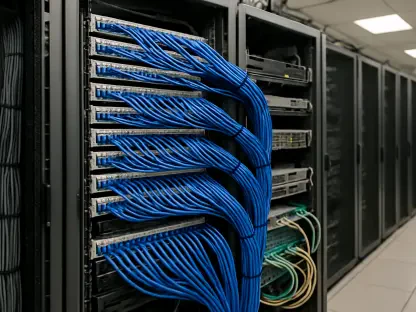As the world becomes increasingly dependent on digital services, the infrastructure supporting these services faces unprecedented challenges. Centralized hyperscale data centers have been the backbone of digital expansion for years, supporting massive data throughput with remarkable efficiency. Yet, the landscape is evolving, and the demands for real-time responsiveness and stringent local compliance are reshaping strategies. In this context, edge data centers are emerging as crucial players. These facilities, smaller and more geographically dispersed than their centralized counterparts, present a promising solution to the bottlenecks of latency and bandwidth limitations. By strategically placing data processing closer to the point of service delivery, edge data centers are poised to integrate seamlessly into existing hyperscale frameworks, turning centralized infrastructures into dynamic networks capable of meeting the growing demands of the digital age.
Hyperscale Challenges Meet Edge Opportunities
Limitations of Centralized Data Centers
The efficiency of hyperscale data centers lies in their ability to centralize vast amounts of data processing within strategically located hubs. Despite their strengths, these facilities are increasingly strained by the requirements of contemporary digital services. Applications requiring ultralow latency, such as those in AI, augmented reality, or autonomous systems, underscore the pitfalls of a solely centralized approach. In such applications, even slight delays can impair functionality, emphasizing the need for more localized data processing.
The bandwidth demands stemming from the constant flow of data to and from centralized locations also contribute to these challenges. The volume of data generated is immense, leading to network congestion and elevated energy consumption. Simultaneously, compliance with data sovereignty regulations further complicates matters. Countries and regions are imposing regulations that demand data be stored and processed within their borders, presenting a significant hurdle for hyperscalers accustomed to the flexibility of global data flows.
Edge Computing: Bridging the Gap
Edge data centers are well-positioned to address these shortcomings, offering a means to bring computing power closer to the end user. By doing so, they can significantly reduce latency and enhance the performance of applications demanding real-time processing. Industries such as smart manufacturing and intelligent transportation can greatly benefit from edge computing, which provides localized data processing necessary for time-sensitive applications. However, the advantages of edge data centers are not limited to mitigating latency issues. They serve as vital components in extending reach into regions where robust network infrastructure might be lacking. By tapping into previously unviable markets and addressing new user segments, hyperscalers can use edge data centers to seize opportunities that remain elusive under a purely centralized model.
The Synergistic Potential of Hybrid Infrastructures
Integrating Hyperscale and Edge Models
The convergence of hyperscale and edge data centers offers a strategic advantage that transcends their individual capabilities. A hybrid infrastructure enables dynamic workload distribution, accommodating the needs of both high-performance centralized cores and localized processing at the edge. This integration ensures that hyperscalers can maintain storage for complex tasks while dispatching latency-sensitive computations to edge nodes. Such an arrangement not only enhances disaster recovery efforts but also bolsters compliance with regional regulations by maintaining localized data processing capabilities.
Moreover, edge facilities often embrace sustainability models that align with contemporary environmental expectations. By integrating renewable energy sources and optimizing energy consumption through local grids, these centers contribute to reducing carbon footprints and promoting transparency in energy use. The move toward hybrid infrastructures illustrates a shift in digital service provision paradigms—one that values both scale and proximity while fostering resilience and sustainability.
Adapting to Regulatory and Consumer Demands
The push for sustainable operations is driven by both regulatory and consumer pressures. As digital services expand, so too does scrutiny regarding their environmental impact. Infrastructure operators are facing calls for greater transparency in energy utilization, necessitating systems that integrate clean energy sources and efficient cooling solutions. Edge data centers, by virtue of their design, often come equipped to address these demands, serving as models for implementing detailed energy monitoring and reporting systems that offer precise, asset-level insights.
Such practices not only fulfill regulatory obligations but resonate with a growing base of environmentally conscious consumers. As digital infrastructures adapt to heightened expectations for accountability and sustainability, edge data centers will play vital roles. By adopting locally-attuned energy strategies, operators can ensure that their facilities align with strategic goals for efficiency and sustainability while paving the way for continued innovation.
Future Directions in Digital Infrastructure
Embracing Scale and Proximity
As the digital landscape continues its rapid evolution, the confluence of scale and proximity will define the strategies of tomorrow’s hyperscalers. Investing in hybrid infrastructures today positions companies to better address emerging trends such as distributed AI deployment and regional digital ecosystems. By integrating edge capabilities seamlessly into pre-existing centralized frameworks, hyperscalers can enhance service delivery, ensuring swift and responsive digital experiences regardless of location.
Looking to the future, effectively balancing centralized and decentralized models will be indispensable for hyperscalers striving to achieve operational excellence without compromising on sustainability. As hyperscalers refine their approaches, edge data centers will not merely supplement existing capabilities but will redefine how digital infrastructure supports a wide array of applications across diverse geographies. The transition from traditional paradigms towards a more expansive and agile strategy reflects a broader commitment to delivering exceptional digital services sustainably and reliably.
Pioneering the Hybrid Model
Hyperscale data centers are efficient due to their ability to centralize extensive data processing in key hubs. However, as digital services evolve, these facilities struggle to meet their demands. Applications like AI, augmented reality, and autonomous systems, which require ultralow latency, highlight the limitations of centralized data processing; even minor latency can affect performance. There’s an increasing need to process data locally to overcome these issues.
Additionally, the ever-growing flow of data to and from these centers increases bandwidth demands, leading to network congestion and higher energy use. Data sovereignty regulations also intensify these challenges, as countries and regions enforce laws that require data to be stored and processed locally. This presents obstacles for hyperscale centers that rely on flexible global data management. Hyperscale providers must navigate these complex regulations, adapting their strategies to ensure compliance while maintaining operational efficiency.









